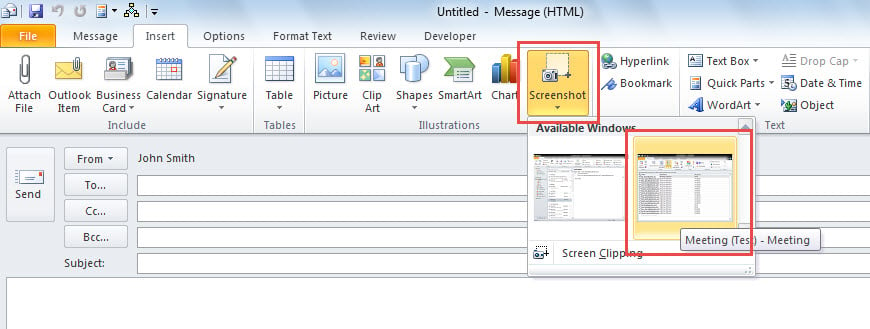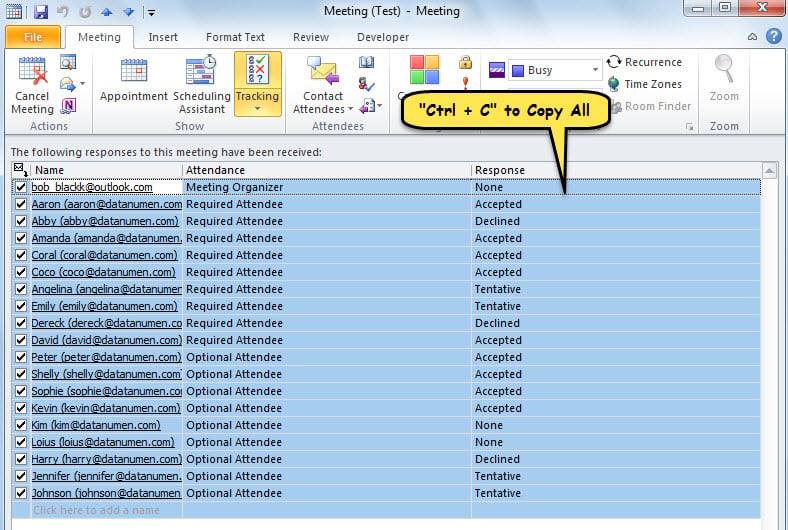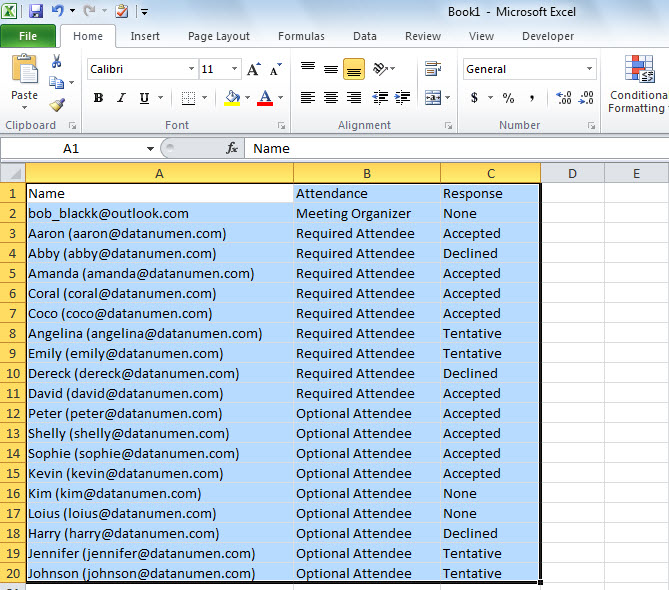After sending a meeting invitation, you can check the recipients’ meeting responses in “Tracking” page of the meeting. If you would like to print the Tracking list, you can use the 3 methods introduced in this article.
Outlook provides users with “Tracking” feature for the meetings. It will list out all the responses from all meeting attendees. Thus, if you hope to check who accept the meeting you organized and who decline, you can just get access to Tracking list. However, there is not a direct function to print the list. Thereby, here we will share you 3 means to quickly print it.
![]()
Method 1: Print “Tracking” Screenshot
- To begin with, open the meeting “Tracking” page.
- Next, create a new email.
- After that, shift to “Insert” tab and click the “Screenshot” button.
- Later, choose the “Tracking” screenshot from “Available Windows” list.
- Finally, go to “File” > “Print” to print out the screenshot of “Tracking”.
Method 2: Print after Copying to Excel
- For a start, access “Tracking” page.
- Subsequently, select one entry in the “Tracking” list.
- Next, press “Ctrl + A” to select all entries.
- Afterwards, press “Ctrl + C” to copy them.
- Then, open a new Excel file.
- Select “A1” cell and press “Ctrl + V” to paste the copied “Tracking” list.
- Eventually, in Excel, go to “File” > “Print” to print the current worksheet.
Method 3: Print with Outlook VBA
- First off, go to Outlook VBA editor by referring to “How to Run VBA Code in Your Outlook“.
- Then, enable “MS Excel Object Library” with accordance to “How to Add an Object Library Reference in VBA“.
- After that, put the code below into a module.
Sub PrintTracking_Meeting()
Dim objMeeting As Outlook.AppointmentItem
Dim objAttendees As Outlook.Recipients
Dim objAttendee As Outlook.Recipient
Dim objExcelApp As Excel.Application
Dim objExcelWorkbook As Excel.Workbook
Dim objExcelWorksheet As Excel.Worksheet
Dim nLastRow As Integer
Set objMeeting = Outlook.Application.ActiveInspector.CurrentItem
Set objAttendees = objMeeting.Recipients
Set objExcelApp = CreateObject("Excel.Application")
Set objExcelWorkbook = objExcelApp.Workbooks.Add
Set objExcelWorksheet = objExcelWorkbook.Sheets(1)
objExcelApp.Visible = True
With objExcelWorksheet
.Cells(1, 1) = "Name"
.Cells(1, 1).Font.Bold = True
.Cells(1, 2) = "Attendance"
.Cells(1, 2).Font.Bold = True
.Cells(1, 3) = "Response"
.Cells(1, 3).Font.Bold = True
End With
For Each objAttendee In objAttendees
nLastRow = objExcelWorksheet.Range("A" & objExcelWorksheet.Rows.Count).End(xlUp).Row + 1
Select Case objAttendee.MeetingResponseStatus
Case olResponseAccepted
With objExcelWorksheet
.Range("A" & nLastRow) = objAttendee.Name
.Range("B" & nLastRow) = GetAttendance(objAttendee.Type)
.Range("C" & nLastRow) = "Accepted"
End With
Case olResponseDeclined
With objExcelWorksheet
.Range("A" & nLastRow) = objAttendee.Name
.Range("B" & nLastRow) = GetAttendance(objAttendee.Type)
.Range("C" & nLastRow) = "Declined"
End With
Case olResponseNone
With objExcelWorksheet
.Range("A" & nLastRow) = objAttendee.Name
.Range("B" & nLastRow) = GetAttendance(objAttendee.Type)
.Range("C" & nLastRow) = "None"
End With
Case olResponseTentative
With objExcelWorksheet
.Range("A" & nLastRow) = objAttendee.Name
.Range("B" & nLastRow) = GetAttendance(objAttendee.Type)
.Range("C" & nLastRow) = "Tentative"
End With
Case olResponseOrganized
With objExcelWorksheet
.Range("A" & nLastRow) = objAttendee.Name
.Range("B" & nLastRow) = GetAttendance(objAttendee.Type)
.Range("C" & nLastRow) = "Organized"
End With
End Select
Next
objExcelWorksheet.Columns("A:C").AutoFit
objExcelWorksheet.PrintOut
End Sub
Function GetAttendance(lType As Long) As String
Select Case lType
Case 0
GetAttendance = "Meeting Organizer"
Case 1
GetAttendance = "Required Attendee"
Case 2
GetAttendance = "Optional Attendee"
End Select
End Function
- Next, add this macro to Quick Access Toolbar (QAT).
- Ultimately, open a meeting and hit the macro button in QAT.
- At once, the tracking list of the meeting will be printed out, as shown in the following figure.
Get back Valuable Outlook Data
If you’re experiencing Outlook file corruption, in the first place, you can check the most recent PST backup. If there isn’t any available backup, it is also an option to make use of the inbuilt repair tool, Scanpst, to attempt PST repair. Yet, assuming that both can’t make effects, your last resort is a more powerful and well-proven external tool, such as DataNumen Outlook Repair.
Author Introduction:
Shirley Zhang is a data recovery expert in DataNumen, Inc., which is the world leader in data recovery technologies, including SQL Server corruption and outlook repair software products. For more information visit www.datanumen.com


